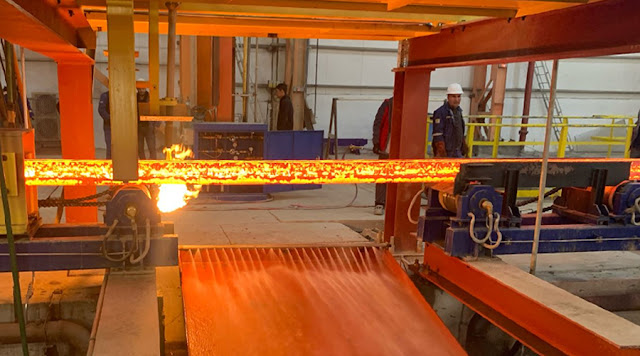Billet Casting Method - Continuous Casting Machine
As a necessary product in the steelmaking industry, billet is a product obtained by casting molten steel in a steelmaking furnace.
Billets Are Produced By Three Process Methods:
First
Through the continuous casting equipment of the steelmaking system, the molten steel is directly cast into the billet;
Second
The semi-finished steel products processed by the rolling equipment of the steel rolling system for the steel ingots or continuous casting billets produced by the steelmaking system;
Third
The semi-finished product processed by the forging equipment for the ingot produced by the steelmaking system.
Billet Casting Method
The raw material for billet casting can be iron sand or scrap iron, which can be melted into molten steel. Blast furnaces are used to make steel with ore as raw materials, while electric arc furnaces are used for scrap iron-based processes.
The specific casting method is as follows:
1. Heat to bond
In the heating and bonding workshop, the iron sand bag is prepared. The iron grit is crushed into normalized particles and heated to bond or stick together.
Heating makes the bonded iron sand drums crushed immediately, and inserted into the blast furnace in an alternating pattern of a layer of coke and a layer of sand drums.
Coke is a solid residue distilled from carbon-rich coal, which is highly combustible.
2. Blast furnace
In the blast furnace, iron is extracted from the iron sand drum. Solid grit and coke are poured into the blast furnace from the top. The combustion of hot gases at the bottom of the blast furnace up to 1200°C produces carbon oxides. It reduces iron oxide through a deoxygenation process, thereby dispersing iron.
The heat generated by the combustion phenomenon melts the iron and waste rock (the mobilization of minerals in the sand trap) into a liquid. Waste rock, because it is relatively light, will float to the surface of iron tap water, which is the "cast iron" that the cartridge seal refers to.
Slag is the residue from melting waste rock that can be used for other industrial purposes, such as paving roads or producing cement.
3. Coke oven
Coke is a combustible material obtained from coal in a coke oven through the process of retorting (gasification of unwanted components).
Coke is almost pure carbon with a porous structure and strong anti-rolling properties.
The phenomenon of coke burning in blast furnaces provides the heat and gas needed to melt the iron grit.
4. Converter
In an oxygen-blown converter, cast iron is converted into steel. Molten cast iron is poured over a layer of iron filings. Unwanted things such as carbon and residues are burnt off by infusing pure oxygen to produce crude steel. The residue or slag is then skimmed off.
Crude steel (so called because it has to undergo further incision) is then poured into the barrel.
5. Electric arc furnace
The discharge into the electric arc furnace may be selected but untreated scrap (such as old mechanical parts), or it may be screened, milled, to specification scrap with at least 92% iron content iron. Scrap iron is melted in an electric arc furnace, which produces molten steel.
For each type of steel, the raw materials must be carefully selected.
The smelting process is driven by a powerful electric arc that "jumps" between the electrodes and the raw material in the furnace. The residue or slag is recovered from the furnace. The resulting molten steel is sealed and fed to the ladle furnace according to the grade.
6. Decarbonization
Incision (decarburization) and inclusion of chemical additives These two operations need to be carried out in a vacuum-sealed vessel. Steel rotates between incisive barrels and vessels with the help of an inert gas, argon.
The smelted molten steel is poured into the mold with the corresponding flow and shape. When the mold is pulled, the molten steel comes into contact with the water-cooled inner wall of the mold and solidifies. Afterwards, the forged metal is drawn down by continuous rolls while continuously cooling. When it reaches the end, the steel is fully solidified and is cut to the desired length upon request.
This produces what we know as a semi-finished product. These semi-finished products can be slabs with a rectangular cross-section, or blocks or billets with a square cross-section. They are all blanks that are used to create the final product.
Through the above content, We believe that everyone has a further understanding of the billet manufacturing method, and we hope it will be helpful to everyone.
For more professional information about the steelmaking and casting industry, please pay more attention to the news on our website.
If you have any other questions, please feel free to contact us at Hani Metallurgy.
E-mail: saleswn@hanrm.com / inquiry66@hanmetallurgy.com ( Daisy )
Xi'an Hani Tech Co.,Ltd.



Comments
Post a Comment